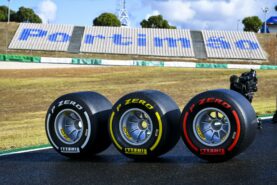Slicks
Slicks are a type of tire used in Formula 1 Grand Prix racing. The term "slick" refers to the tire's smooth surface without any tread pattern. Slicks are made of a soft rubber compound that offers maximum grip on the track surface, allowing the car to achieve higher speeds and greater cornering forces.
In contrast to grooved tires, which were used in wet conditions to displace water from the track surface, slicks are designed to be used on dry tracks. They have no tread pattern, which maximises the contact patch between the tire and the track, resulting in superior grip and better handling.
Slick tires have been the standard tire type used in Formula 1 since the 1970s. Prior to that, tires had a heavily grooved pattern designed to channel water away from the track surface. The introduction of slicks revolutionised the sport, allowing drivers to push their cars to the limits and achieve faster lap times.
Slicks come in a range of compounds, each offering different levels of grip and durability. The choice of compound depends on the track conditions and weather. Softer compounds offer better grip, but wear out faster, while harder compounds last longer but provide less grip.
In recent years, there has been a move towards wider slick tires, designed to increase mechanical grip and improve lap times. In 2017, Formula 1 introduced wider tires as part of a major rules overhaul, resulting in some of the fastest lap times in the sport's history.
Slicks are a critical component of Formula 1 racing, offering maximum grip and allowing drivers to push their cars to the limits. With advances in tire technology, slicks continue to play an important role in the sport, helping to set new lap records and push the boundaries of what is possible on the track.












LAST 3 F1 Fan COMMENTS